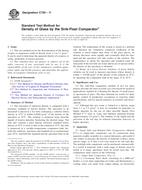Potrebujeme váš súhlas na využitie jednotlivých dát, aby sa vám okrem iného mohli ukazovať informácie týkajúce sa vašich záujmov. Súhlas udelíte kliknutím na tlačidlo „OK“.
ASTM C978-04(2014)
Standard Test Method for Photoelastic Determination of Residual Stress in a Transparent Glass Matrix Using a Polarizing Microscope and Optical Retardation Compensation Procedures
Automaticky preložený názov:
Štandardná skúšobná metóda pre stanovenie fotoelastického zvyškových napätí v priehľadnej sklenenej matrici Použitím polarizačným mikroskopom a optických prístrojov a postupy vyrovnania retardácia
NORMA vydaná dňa 1.5.2014
Informácie o norme:
Označenie normy: ASTM C978-04(2014)
Poznámka: NEPLATNÁ
Dátum vydania normy: 1.5.2014
Kód tovaru: NS-15929
Počet strán: 9
Približná hmotnosť: 27 g (0.06 libier)
Krajina: Americká technická norma
Kategória: Technické normy ASTM
Kategórie - podobné normy:
Anotácia textu normy ASTM C978-04(2014) :
Keywords:
ICS Number Code 81.040.10 (Raw materials and raw glass)
Doplňujúce informácie
| Significance and Use | ||||||||
|
5.1 The quality and performance of an article of glassware may be affected not only by the presence of residual stresses due to heat treatment above the strain point in the ware, but also by additional residual stresses caused by differences in thermal expansion between the glass substrate, and either cord, fired-on vitreous enamel, or ACL decoration. 5.2 The effects of those additional residual cord, enamel, or ACL stresses and the resulting performance of such items may be evaluated by performance test procedures. Such evaluations of enamel or ACL stresses may also be accomplished through the determination of appropriate physical properties of the decoration and matrix glass, or by analytical methods. 5.3 This test method offers a direct and convenient means of determining the magnitudes and spatial distributions of residual stress systems in glass substrates. The test method is simple, convenient, and quantitatively accurate. 5.4 This test method is useful in evaluating the degree of compatibility between the coefficient of thermal expansion of an enamel or ACL applied to a glass substrate. |
||||||||
| 1. Scope | ||||||||
|
1.1 This test method covers the determination of residual stresses in a transparent glass matrix by means of a polarizing microscope using null or retardation compensation procedures. 1.2 Such residual stress determinations are of importance in evaluating the nature and degree of residual stresses present in glass matrixes due to cord, or the degree of fit, or suitability of a particular combination of glass matrix and enamel, or applied color label (ACL). 1.3 The retardation compensation method of optically determining and evaluating enamel or ACL residual stress systems offers distinct advantages over methods requiring physical property measurements or ware performance tests due to its simplicity, reproducibility, and precision. 1.4 Limitations—This test method is based on the stress-optical retardation compensation principle, and is therefore applicable only to transparent glass substrates, and not to opaque glass systems. 1.5 Due to the possibility of additional residual stresses produced by ion exchange between glasses of different compositions, some uncertainty may be introduced in the value of the stress optical coefficient in the point of interest due to a lack of accurate knowledge of chemical composition in the areas of interest. 1.6 This test method is quantitatively applicable to and valid only for those applications where such significant ion exchange is not a factor, and stress optical coefficients are known or determinable. 1.7 The extent of the ion exchange process, and hence the magnitudes of the residual stresses produced due to ion exchange will depend on the exchange process parameters. The residual stress determinations made on systems in which ion exchange has occurred should be interpreted with those dependencies in mind. 1.8 The values stated in SI units are to be regarded as the standard. The values given in parentheses are for information only. 1.9 This standard does not purport to address all of the safety concerns, if any, associated with its use. It is the responsibility of the user of this standard to establish appropriate safety and health practices and determine the applicability of regulatory limitations prior to use. |
||||||||
| 2. Referenced Documents | ||||||||
|
Podobné normy:
Historická
1.10.2013
Historická
1.10.2011
Historická
1.10.2013
Historická
1.10.2013
Historická
1.10.2013
Historická
1.10.2011
Odporúčame:
Aktualizácia technických noriem
Chcete mať istotu, že používate len platné technické normy?
Ponúkame Vám riešenie, ktoré Vám zaistí mesačný prehľad o aktuálnosti noriem, ktoré používate.
Chcete vedieť viac informácií ? Pozrite sa na túto stránku.



 ASTM C338-93(2013)..
ASTM C338-93(2013).. ASTM C429-01(2011)..
ASTM C429-01(2011).. ASTM C598-93(2013)..
ASTM C598-93(2013).. ASTM C657-93(2013)..
ASTM C657-93(2013).. ASTM C693-93(2013)..
ASTM C693-93(2013).. ASTM C729-11
ASTM C729-11
 Cookies
Cookies
